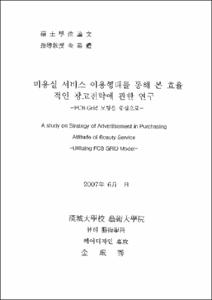미용실 서비스 이용행태를 통해 본 효율적인 광고전략에 관한 연구
- Abstract
- As many industries are heading towards higher degree of maturity and market competition becomes more severe, it is getting more difficult for beauty shops to differentiate their products only with main attributes. In their effort to address these challenges, many companies attempt to differentiate their brands by appealing to consumer's emotional aspects.
This step is implemented for four product categories classified based on the FCB Grid. Furthermore, the ultimate objective of this study is to newly establish advertisement strategy by utilizing the main features of FCB Grid model. Since the direction of advertisement strategy can be
established by analyzing the difference on the value system of4 products groups divided into the axis of intervention, reason and emotion in the existing FCB Grid model, it is expected that innovative advertisement strategy can be established for beauty shop service, the subject of this study, by analyzing consumer's purchasing attitude.
It was also examined what results and alteration were caused, during the process of decision making for purchase, by diverse variables, i.e, demographic and statistical factors such as age or educational background or consumer's economic environment.
This study aims at providing basic data for the beauty industry to establish more reasonable marketing plans for costumers identified into their propensity and buying behaviors in terms of FCB Grid.
For this study, both theoretical and empirical researches had been performed. The former included theories as well as previous studies on FCB Grid theory and characters of beauty service industry.
The subject people were 255 living Seoul and Kyung-ki-do, and the study was performed by the questionnaire survey.
Responses were analyzed with the SPSS 12.0 program for factor analysis, frequency analysis, X^(2) -test, correlation analysis.
The results of this study are as follows:
1. Costumers were classified into four types according to FCB Grid theory.
High involvement-think oriented, high involvement-feel oriented, low involvement-think oriented, low involvement-feel oriented. As for the differences among four propensities types in terms of demographic characteristics, age, marriage, jobs and average monthly incomes were discovered to make difference.
2. The result of the differences between their main purchasing service in beauty salon and buying behaviors is as followed.
Cut costumers are more rational than permanent costumers.
3. Advertising strategy should be subdivide according to the various positions of costumers' purchasing attitude.
- Issued Date
- 2007
- Awarded Date
- 2007-08
- Type
- Thesis
- Files in This Item:
-
-
Download
 000000557045.pdf
기타 데이터 / 2.15 MB / Adobe PDF
000000557045.pdf
기타 데이터 / 2.15 MB / Adobe PDF
-
Items in Repository are protected by copyright, with all rights reserved, unless otherwise indicated.